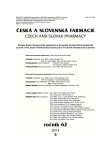Influence of temperature and concentration of a surfactant on pharmaceutical availability
Authors:
Petra Herdová; Zuzana Vitková; Jarmila Oremusová; Alexandra Kodadová
Authors place of work:
Univerzita Komenského v Bratislave
; Farmaceutická fakulta, Katedra galenickej farmácie
; PharmDr. Petra Herdová, PhD. (∗) • Zuzana Vitková • Alexandra Kodadová
Published in the journal:
Čes. slov. Farm., 2013; 62, 223-226
Category:
Původní práce
Summary
This study aimed to analyze the influence of surfactant concentration and temperature on drug liberation from hydrogels and their flow properties. The surfactant benzethonium chloride (BZCl) was used in concentrations of 0.01, 0.1 and 0.5 % (w/w), while the drug chlorhexidine dihydrochloride (CHX) was used in a concentration of 0.1 % (w/w). Chitosan (CHIT) in 2.5 % (w/w) concentration was used as a gel-creating substance. The drug and surfactant liberation were evaluated within the temperature range of 25–40 °C. The largest amounts of both of them were liberated at the temperature of 40 °C. Through the concentration changes it was possible to obtain statistically significant differences (P < 0.05) between the liberation of CHX and BZCl. An analysis of the flow properties revealed that the character of the plastic system was not influenced by the changing concentration of the surfactant. The experimental results led to the conclusion that the optimum composition of the gel was as follows: 2.5 % (w/w) CHIT + 0.1 % (w/w) CHX + 0.01 % (w/w) BZCl.
Keywords:
chlorhexidine dihydrochloride •benzethonium chloride • chitosan • liberation • critical micelle concentration
Zdroje
1. Rangel-Yagui C. O., Pessoa A., Tavares L. C. Micellar Solubilization of Drugs. J Pharm Pharmaceut Sci 2005; 8(2), 147–165.
2. Bartovská L. Fyzikální chemie povrchových a koloidných soustav. 5 vyd. Praha: VŠCHT 2005; 244, 186–191.
3. Kim H-U., Lim K-H. A model on the temperature dependence of critical micelle concentration. Colloids and Surfaces A: Phys. Chem. Engin. Aspects, 2004; 235(1–3), 121–128.
4. Chen L-J., Lin S-Y., Huang C.C., Chen E. M. Temperature dependence of critical micelle concentration of polyoxyethylenated non- ionic surfactants. Colloids and Surfaces A: Phys. Chem. Engin. Aspects,1998; 135(1–3), 175–181.
5. Schramm L. L., Stasiuk E. N., Marangoni D. G. Surfactants and their applications. Annu. Rep. Prog. Chem., Sect. C, 2003; 99, 3–48.
6 http://pubchem.ncbi.nlm.nih.gov/summary/summary.cgi?sid= 162180433&loc=es_rss#x395[cit. 3.9.2013]
7. http://cameochemicals.noaa.gov/chemical/19856 [cit. 26.8.2013]
8. NTP Toxicology and Carcinogenesis Studies of Benzethonium Chloride (CAS No. 121-54-0) in F344/N Rats and B6C3F1 Mice (Dermal Studies). Natl Toxicol Program Tech Rep Ser. 1995; 438, 1–220.
http://www.ncbi.nlm.nih.gov/pubmed/12595925 [cit. 20.8.2013]
9. Kiselovičová M. Štúdium interakcií katiónového tenzidu s vybranými liečivami (lokálne anestetiká). Diplomová práca. Bratislava: Univerzita Komenského, Farmaceutická fakulta, 2012; 62.
Štítky
Farmácia FarmakológiaČlánok vyšiel v časopise
Česká a slovenská farmacie

2013 Číslo 5
Najčítanejšie v tomto čísle
-
Standardní receptura pro přípravu léčivých přípravků v lékárnách
VI. Sbírka Neues Rezeptur-Formularium* - Kombinace extraktu z grapefruitových semínek a koncentrované šťávy z klikvy velkoplodé jako potenciální protimikrobní konservans ke zvýšení mikrobiologické stability hypromelosového gelu
- Vplyv teploty a koncentrácie tenzidu na farmaceutickú dostupnosť liečiva
- Prof. Ing. Milan Remko, DrSc. CChem FRSC – 65 ročný
